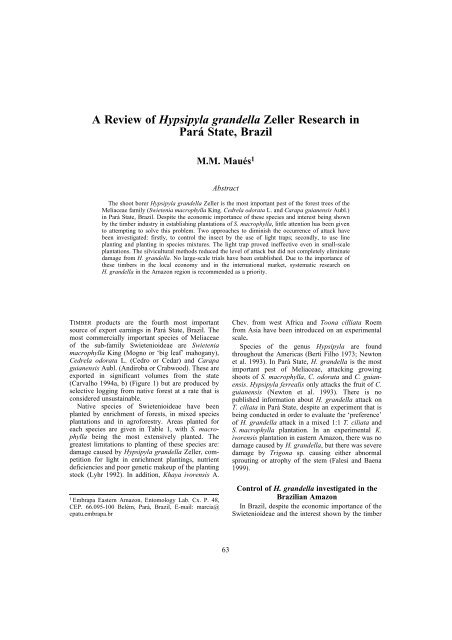Hypsipyla Shoot Borers of Meliaceae in Sri Lanka - Australian ...
Hypsipyla Shoot Borers of Meliaceae in Sri Lanka - Australian ...
Hypsipyla Shoot Borers of Meliaceae in Sri Lanka - Australian ...
You also want an ePaper? Increase the reach of your titles
YUMPU automatically turns print PDFs into web optimized ePapers that Google loves.
A Review <strong>of</strong> <strong>Hypsipyla</strong> grandella Zeller Research <strong>in</strong><br />
Pará State, Brazil<br />
M.M. Maués 1<br />
Abstract<br />
The shoot borer <strong>Hypsipyla</strong> grandella Zeller is the most important pest <strong>of</strong> the forest trees <strong>of</strong> the<br />
<strong>Meliaceae</strong> family (Swietenia macrophylla K<strong>in</strong>g, Cedrela odorata L. and Carapa guianensis Aubl.)<br />
<strong>in</strong> Pará State, Brazil. Despite the economic importance <strong>of</strong> these species and <strong>in</strong>terest be<strong>in</strong>g shown<br />
by the timber <strong>in</strong>dustry <strong>in</strong> establish<strong>in</strong>g plantations <strong>of</strong> S. macrophylla, little attention has been given<br />
to attempt<strong>in</strong>g to solve this problem. Two approaches to dim<strong>in</strong>ish the occurrence <strong>of</strong> attack have<br />
been <strong>in</strong>vestigated: firstly, to control the <strong>in</strong>sect by the use <strong>of</strong> light traps; secondly, to use l<strong>in</strong>e<br />
plant<strong>in</strong>g and plant<strong>in</strong>g <strong>in</strong> species mixtures. The light trap proved <strong>in</strong>effective even <strong>in</strong> small-scale<br />
plantations. The silvicultural methods reduced the level <strong>of</strong> attack but did not completely elim<strong>in</strong>ate<br />
damage from H. grandella. No large-scale trials have been established. Due to the importance <strong>of</strong><br />
these timbers <strong>in</strong> the local economy and <strong>in</strong> the <strong>in</strong>ternational market, systematic research on<br />
H. grandella <strong>in</strong> the Amazon region is recommended as a priority.<br />
TIMBER products are the fourth most important<br />
source <strong>of</strong> export earn<strong>in</strong>gs <strong>in</strong> Pará State, Brazil. The<br />
most commercially important species <strong>of</strong> <strong>Meliaceae</strong><br />
<strong>of</strong> the sub-family Swietenioideae are Swietenia<br />
macrophylla K<strong>in</strong>g (Mogno or ‘big leaf’ mahogany),<br />
Cedrela odorata L. (Cedro or Cedar) and Carapa<br />
guianensis Aubl. (Andiroba or Crabwood). These are<br />
exported <strong>in</strong> significant volumes from the state<br />
(Carvalho 1994a, b) (Figure 1) but are produced by<br />
selective logg<strong>in</strong>g from native forest at a rate that is<br />
considered unsusta<strong>in</strong>able.<br />
Native species <strong>of</strong> Swietenioideae have been<br />
planted by enrichment <strong>of</strong> forests, <strong>in</strong> mixed species<br />
plantations and <strong>in</strong> agr<strong>of</strong>orestry. Areas planted for<br />
each species are given <strong>in</strong> Table 1, with S. macrophylla<br />
be<strong>in</strong>g the most extensively planted. The<br />
greatest limitations to plant<strong>in</strong>g <strong>of</strong> these species are:<br />
damage caused by <strong>Hypsipyla</strong> grandella Zeller, competition<br />
for light <strong>in</strong> enrichment plant<strong>in</strong>gs, nutrient<br />
deficiencies and poor genetic makeup <strong>of</strong> the plant<strong>in</strong>g<br />
stock (Lyhr 1992). In addition, Khaya ivorensis A.<br />
1 Embrapa Eastern Amazon, Entomology Lab. Cx. P. 48,<br />
CEP. 66.095-100 Belém, Pará, Brazil, E-mail: marcia@<br />
cpatu.embrapa.br<br />
63<br />
Chev. from west Africa and Toona cilliata Roem<br />
from Asia have been <strong>in</strong>troduced on an experimental<br />
scale.<br />
Species <strong>of</strong> the genus <strong>Hypsipyla</strong> are found<br />
throughout the Americas (Berti Filho 1973; Newton<br />
et al. 1993). In Pará State, H. grandella is the most<br />
important pest <strong>of</strong> <strong>Meliaceae</strong>, attack<strong>in</strong>g grow<strong>in</strong>g<br />
shoots <strong>of</strong> S. macrophylla, C. odorata and C. guianensis.<br />
<strong>Hypsipyla</strong> ferrealis only attacks the fruit <strong>of</strong> C.<br />
guianensis (Newton et al. 1993). There is no<br />
published <strong>in</strong>formation about H. grandella attack on<br />
T. ciliata <strong>in</strong> Pará State, despite an experiment that is<br />
be<strong>in</strong>g conducted <strong>in</strong> order to evaluate the ‘preference’<br />
<strong>of</strong> H. grandella attack <strong>in</strong> a mixed 1:1 T. ciliata and<br />
S. macrophylla plantation. In an experimental K.<br />
ivorensis plantation <strong>in</strong> eastern Amazon, there was no<br />
damage caused by H. grandella, but there was severe<br />
damage by Trigona sp. caus<strong>in</strong>g either abnormal<br />
sprout<strong>in</strong>g or atrophy <strong>of</strong> the stem (Falesi and Baena<br />
1999).<br />
Control <strong>of</strong> H. grandella <strong>in</strong>vestigated <strong>in</strong> the<br />
Brazilian Amazon<br />
In Brazil, despite the economic importance <strong>of</strong> the<br />
Swietenioideae and the <strong>in</strong>terest shown by the timber

















